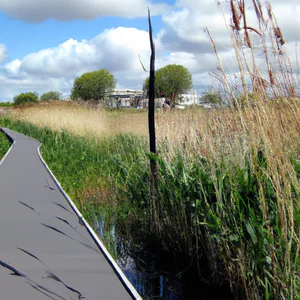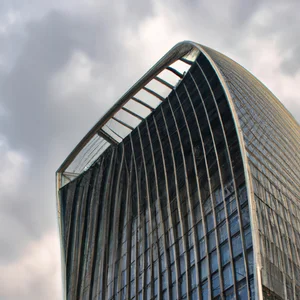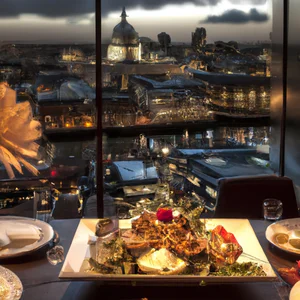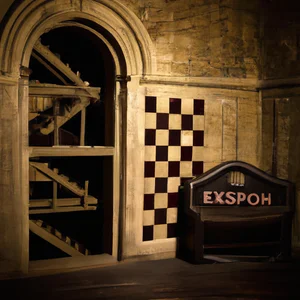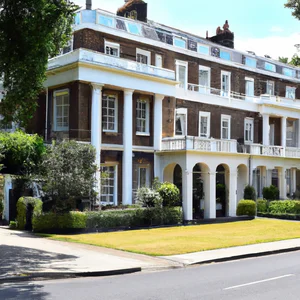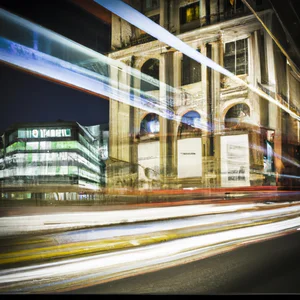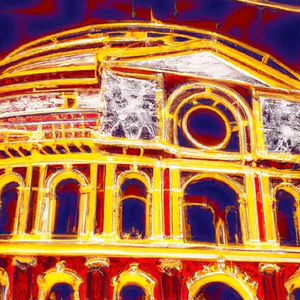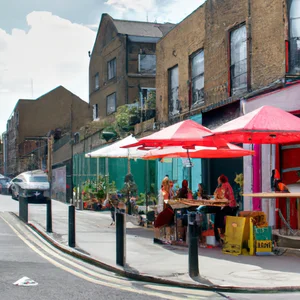Book your experience
London Mithraeum: Ancient and modern architecture at the site of London's Roman temple
Ah, the London Mithraeum! A real treat for those who love mixing past and present, you know? It’s located right where a Roman temple once stood, and it’s a place worth visiting. Imagine an old temple, with its columns and the remains of an architecture that tells stories from two thousand years ago. But it’s not just history: there is also a touch of modernity here that is truly impressive.
When I went there, I was struck by how the architects managed to blend the new with the old. The soft lights, the almost mystical atmosphere… for a moment, I almost heard the whisper of the ancient priests as they celebrated their rites. And, oh, let’s not talk about the choice of materials! It’s like they took a piece of history and put it in a modern setting.
In short, I’m not sure, but I think it’s a place that makes you think, a bit like when you watch a film that hits you straight in the heart. History embraces you, while modernity makes you feel alive, in short, a truly fascinating mix. And I’ll tell you, if you happen to be walking around, don’t forget to check out this place. It’s like finding a hidden treasure amidst the frenzy of London, and I assure you you won’t regret it!
Discover the London Mithraeum: a hidden Roman temple
When I first stepped into the London Mithraeum, a shiver of wonder ran through my body. This hidden corner of London, located beneath Bloomberg’s modern buildings, is a true treasure trove of history. I vividly remember the feeling of being in a place where time seems to have stopped, immersed in an atmosphere that mixes the ancient and the contemporary. The stone walls that surrounded me told stories of rituals and a cult that captivated the Roman Empire.
An archaeological treasure in the heart of London
The Mithraeum was discovered in 1954, but its history dates back to the 2nd century AD, when the Romans venerated Mithra, the god of light and truth. This underground temple offers visitors a unique opportunity to immerse themselves in a distant era. Access is free, but it is advisable to book in advance to avoid long waits. For more details, you can visit Bloomberg’s official website, which offers updates on visits and special events.
Unconventional advice
Many visitors rush to leave the Mithraeum after exploring it, but one secret that only true connoisseurs know is to take the time to sit quietly in the contemplation area. This moment of pause allows you to savor the mystical atmosphere of the place, while the digital lights and sounds recreate the Roman era. It’s an experience that connects you deeply with the past.
The cultural impact of the Mithraeum
The London Mithraeum is not just an archaeological site; it is a symbol of London’s cultural resilience. Its discovery reignited interest in the city’s Roman roots, highlighting a period of great vitality and cultural exchange. Today, the Mithraeum represents a bridge between the past and the present, a place where ancient stories intertwine with modern life.
Sustainability and responsible tourism
Another interesting aspect is Bloomberg’s commitment to sustainability. The site is designed to be eco-friendly, using technologies that minimize environmental impact. This approach reflects a growing interest in responsible tourism, encouraging visitors to respect and preserve cultural and historical heritages.
An activity not to be missed
During your visit, don’t forget to participate in one of the immersive activities that regularly take place at the Mithraeum, such as historical reenactments or lectures on Roman cults. These experiences enrich your understanding of the place and give you even deeper context.
Dispelling the myths
A common misconception is that the Mithraeum is only a place of worship, but in reality it was also a social center for the Romans, a place where men gathered to discuss business and philosophy. This aspect makes the site even more fascinating, demonstrating how the ancient and the modern can coexist.
In conclusion, a visit to the London Mithraeum is much more than a simple tour of an archaeological site; it is a journey through time that invites us to reflect on the continuity of history. Have you ever wondered what stories can hide behind the walls that surround us? This Roman temple, with its enigmatic aura, is just one example of how the past continues to influence our present.
Contemporary architecture: a dialogue with the past
Walking along the streets of London, the feeling of being at a crossroads of eras is undeniable. My visit to the London Mithraeum was an experience that accentuated this contrast between ancient and modern. I vividly remember the moment I crossed the threshold of this hidden Roman temple, nestled beneath Bloomberg’s imposing contemporary architecture. The glass and steel structure not only embraces the past, but enhances it, creating a visual and cultural dialogue that leaves you speechless.
A refuge of history and innovation
The London Mithraeum, also known as the Temple of Mithras, is a perfect example of how contemporary architecture can respect and enhance historical heritage. The reconstruction of the site was able to integrate modern design elements with Roman architectural wisdom, in a harmonious balance. The light diffused between the temple’s original columns, which date back to the 3rd century AD, mixes with modern art installations, creating an atmosphere that invites contemplation.
If you’re planning a visit, do yourself a favor and book your free entry via Bloomberg’s official site. Don’t forget to check out the latest temporary exhibitions which often take place in the fascinating setting of the Mithraeum. The curators are known for their ability to combine contemporary art and ancient history, making each visit a unique experience.
An insider tip
A well-kept secret is that, after your visit to the Mithraeum, you can head to the nearby Bloomberg Garden, a surprisingly quiet green spot in the heart of London. Here, you’ll find outdoor artworks and installations that tell stories of London, creating a natural extension of the cultural experience you’ve just had.
The cultural impact
This architectural dialogue is not only an aesthetic masterpiece; it also represents an important step towards valorising the Roman heritage in London. The preservation and illumination of the Mithraeum not only educates visitors about the history of the Mithra cult, but also asks broader questions about our relationship with the past and how it continues to influence the present.
Responsible tourism practices
In an age where responsible tourism is more important than ever, the London Mithraeum stands out for its commitment to sustainability. The facility is designed to reduce environmental impact, using eco-friendly technologies and recycled materials. Choosing to visit places like this also means supporting initiatives that promote more aware and respectful tourism.
An experience that invites contemplation
Imagine sitting on one of the wooden benches in the garden, surrounded by aromatic plants and works of art, reflecting on the fusion of eras you have just experienced. This is a moment to savor the beauty of the dialogue between the ancient and the contemporary, an opportunity to consider how the past continues to inform and inspire us.
Final reflection
Have you ever thought about how architecture can tell stories that go beyond just stones and bricks? At the London Mithraeum, every detail is a piece that contributes to a larger narrative, an invitation to reflect on how our built environment can reveal the challenges and aspirations of different eras. The next time you find yourself in front of an architectural work, ask yourself: What stories could it tell?
Sensory experience: lights and sounds in the Mithraeum
A journey through time
I still remember my first visit to the London Mithraeum, an experience that exceeded all expectations. As I descended the stairs leading to the Roman temple, the buzz of the city faded, replaced by an enveloping and almost mystical atmosphere. The soft lights and ambient sounds created a totally immersive effect, transporting me to a time when the cult of Mithra fascinated Roman citizens. Each step seemed to awaken the ghosts of the past, making palpable the history that lay beneath my feet.
Practical information
Located in the heart of London, the Mithraeum is easily accessible by public transport. Hours of operation are generally Tuesday through Sunday, but it’s a good idea to check Bloomberg’s official website for any updates or special events. Entrance is free, but booking is recommended to avoid long waits. Don’t forget to bring headphones for a complete audio experience: each visitor receives a device that amplifies the sounds and evocative atmospheres that characterize the site.
Unconventional advice
If you want a truly unique experience, visit the Mithraeum during one of its guided meditation sessions. These events, although little publicized, offer an amazing opportunity to connect with your surroundings and reflect on the spirituality of the place. It is a way to savor not only the architectural beauty, but also the mysterious energy that pervades the temple.
A lasting cultural impact
The cult of Mithra, which flourished between the 1st and 4th centuries AD, had a significant impact on Roman culture and, by extension, modern London. The mystery rituals and celebrations related to Mithra not only influenced religion but also shaped the social and cultural life of the time. Today, the Mithraeum serves as a bridge between the past and the present, offering visitors an opportunity to explore the historical roots of the British capital.
Responsible tourism practices
The London Mithraeum is an example of how cultural heritage can be preserved and enhanced in a sustainable way. Concern for the environment is evident not only in the site’s conservation, but also in management practices that encourage visitors to respect local history and culture. By participating in events or organized tours, tourists can help keep this precious corner of history alive.
Immerse yourself in the atmosphere
Imagine being surrounded by lighting that changes with the phases of the day, while gentle sounds of water and distant singing resonate in the air. The sensory experience at the Mithraeum is designed to stimulate reflection and create an emotional connection with the place. Every detail, from the lights dancing on the ancient stones to the sounds echoing in the temple, helps make your trip unforgettable.
Activities to try
In addition to visiting the Mithraeum, I recommend attending an art and history workshop that is held regularly near the site. These events offer a unique opportunity to deepen your understanding of Roman history and create your own little piece of art inspired by the cult of Mithra.
Common myths
A common misconception is that the Mithraeum is just a boring, static place of worship. Instead, its lively atmosphere and immersive experiences offer a unique opportunity to explore history in a completely new way. It is not just a museum, but an experience that involves all the senses.
Final reflection
After exploring the London Mithraeum, I wondered: how can historic places continue to influence our modern lives? Perhaps, each visit to a site like this invites us to reflect on how the past and present are intertwined in ways we had never imagined. Are you ready to discover your connection to history?
Fascinating story: the cult of Mithra in London
An encounter with the past
I vividly remember the first time I crossed the threshold of the London Mithraeum, a place that seems to whisper forgotten stories. The soft light that filtered through small openings and the echo of my footsteps on the stone floor created an almost mystical atmosphere. In that moment, I felt transported back in time, immersed in an era when mystery cults like that of Mithra fascinated the men and women of the Roman Empire.
The cult of Mithra: an introduction
The cult of Mithra, which dates back to the 2nd century AD, was particularly popular among Roman soldiers and the merchant classes. Mithra, deity of the sun, was venerated in underground temples, known as Mithraeum, dedicated to secret celebrations and mystery rituals. These places were characterized by an atmosphere of intimacy and sacredness, where communities gathered to share spiritual and social experiences.
Practical information
If you would like to delve deeper into the history of this extraordinary cult, the London Mithraeum is open to the public and entry is free. It is located in Bloomberg’s new European headquarters, in a strategic position in the heart of London. It is advisable to book in advance through the official website, where you will also find information on special events and guided tours.
An insider tip
A little-known tip concerns night visits. Many tourists visit the Mithraeum during the day, but the atmosphere as evening falls is simply enchanting. The soft lighting enhances the architecture and historic details, creating an experience that is as visual as it is emotional. Don’t forget to bring a camera - the magic of the Mithraeum at sunset is something you’ll want to capture.
Cultural and historical impact
The cult of Mithra had a significant impact on Roman culture and religion, influencing early Christianity and other spiritual traditions. Symbolic elements of the cult, such as the sacrifice of the bull, have been echoed in many other faiths and practices. Visiting the Mithraeum is not just a journey through time, but an opportunity to reflect on how ancient beliefs continue to shape our modern culture.
Sustainability and responsible tourism
The London Mithraeum is also an example of how tourism can be sustainable. The facility was designed to reduce environmental impact and promote interest in local history. Participating in events and initiatives organized here means contributing to a greater cause: the preservation of our cultural heritage.
An experience not to be missed
As you explore the Mithraeum, don’t forget to stop in the Bloomberg Garden, a corner of tranquility that invites deeper reflections. Here, among exotic plants and contemporary sculptures, you will have the opportunity to meditate on the interconnection between past and present.
Myths and misconceptions
A common misconception is that the Mithra cult was exclusively male. In fact, although most of his followers were men, there is evidence that women could participate in the rituals, albeit in a more limited way. This aspect demonstrates the complexity of the social dynamics of that time.
Personal reflection
As I left the Mithraeum, I couldn’t help but wonder how ancient practices and beliefs continue to influence our daily lives. What are the stories that we carry with us and that, like the cult of Mithra, deserve to be told and listened to? There next time you walk the streets of London, stop and reflect on how deep the connection is between the past and the present.
Guided tour: secrets and stories not to be missed
A fascinating experience
When I first set foot in the London Mithraeum, the feeling of being in a place full of history was palpable. The guide, an expert archaeologist with a contagious passion, began to tell us stories of ancient rites and faithful devotees to the cult of Mithra. I remember with particular vividness the moment when he led us into a dark corner of the temple, revealing an ancient fresco that seemed to tell stories of epic victories and sacrifices. * His words, accompanied by an evocative atmosphere, transported me back in time, making me feel part of a forgotten world *.
Practical information
Guided tours of the London Mithraeum are available every day, but it is advisable to book in advance, especially at weekends. The duration is approximately one hour and includes exclusive access to sections of the site that are not visible to the unaccompanied public. You can find up-to-date information and book your place on the official website of Bloomberg, which manages the Mithraeum. It’s an unmissable opportunity for anyone who wants to delve deeper into London’s history and discover an unexpected side of the capital.
An insider tip
A little-known tip is to ask your guide to tell anecdotes about recent archaeological discoveries. Often, there are unpublished stories that are not mentioned in the standard tour, such as the discovery of personal items left by Mithra devotees. These details can offer a new level of understanding and connection to the past.
The cultural impact of the Mithraeum
The London Mithraeum is not just a place of worship; it also represents a crossroads of cultures and beliefs during the Roman era. The rediscovery of this temple has had a significant impact on the understanding of Roman London and its social dynamics. This site helped rewrite the history of the capital, demonstrating that London was an important center of cultural and spiritual exchange.
Responsible tourism practices
Visiting it is a way to support sustainable tourism. Bloomberg has invested in the conservation of the site and promotes eco-friendly practices, such as the use of technologies to reduce environmental impact. By choosing to visit the Mithraeum, you help preserve this precious historical heritage for future generations.
Suggestive atmosphere
Imagine walking in an environment that combines the ancient with the contemporary, with soft lights dancing on the stone walls and sounds that evoke the echoes of past rituals. Each visit to the Mithraeum is an immersive experience that stimulates the senses and invites reflection. The combination of modern architecture and classical archeology creates a contrast that fascinates and enchants.
An activity worth trying
After the guided tour, I recommend stopping by the Bloomberg Garden, located nearby. Here you can enjoy a moment of relaxation surrounded by greenery, reflecting on the stories you have just heard. It is a perfect place to take photographs and enjoy the tranquility, away from the hustle and bustle of the city.
Myths and misconceptions
A common misconception about the London Mithraeum is that it is just a “tick off” tourist attraction. However, it is much more: it is a place of learning and discovery that offers deep insight into the religious beliefs and practices of the Roman era. Don’t be fooled by its small size; the richness of the stories it contains is astonishing.
A final reflection
After this experience, I asked myself: how many more stories like that of the Mithraeum lie hidden beneath the streets of London? The city is a stage of secrets and legends, and each visit has the power to reveal a new chapter in its fascinating history . If you find yourself in London, don’t miss the opportunity to discover the secrets that the Mithraeum has to offer.
Sustainability: how the Mithraeum promotes responsible tourism
During my visit to the London Mithraeum, I had an experience that changed the way I see tourism. As I explored the ruins of this ancient Roman temple, a thought came to mind: how can we preserve such precious places for future generations? It was precisely in that mystical atmosphere, with the soft lights and enveloping sounds, that I realized that the Mithraeum is not just an archaeological site, but a clear example of how innovation and sustainability can coexist.
A dialogue between ancient and modern
The London Mithraeum is not only a window into the past, but also a beacon of sustainability. Located beneath Bloomberg London, the area has been designed with environmental impact in mind. The use of recycled materials and green technologies was fundamental in its creation. According to the Bloomberg report, the project gained recognition for its commitment to sustainability, aiming to reduce carbon emissions and promote responsible practices.
A tip for responsible travelers
For those who want an experience that goes beyond simple tourism, I highly recommend taking one of the sustainable guided tours offered by the Mithraeum. These visits not only delve into the history of the Mithra cult, but also include discussions on how visitors can contribute to the preservation of these places. It is an opportunity to reflect on how each person can make a difference, even with small gestures such as choosing not to leave waste or to use ecological means of transport.
The cultural impact
The cult of Mithra, which dates back to Roman times, has profoundly influenced culture and religion in Western Europe. Today, the Mithraeum becomes a symbol of how the past can inform modern sustainability practices. The ability to combine history and innovation offers a new perspective on tourism, encouraging visitors to consider their environmental impact as they explore London’s rich history.
An immersive sensory experience
Imagine being immersed in an atmosphere that combines the past with a sustainable future. The lights of the Mithraeum dance on the ancient walls, while the evocative sounds of the cult of Mithra create a multi-sensory experience. This dialogue between ancient and modern invites visitors to reflect on how we can honor our heritage while maintaining a commitment to our planet.
Myths to dispel
A common misconception is that visiting historic places like the Mithraeum can be harmful to the environment. In reality, sites like this demonstrate that, if managed correctly, they can become models of responsible tourism. The key is to inform yourself and choose experiences that respect and preserve our cultural and natural heritage.
A final reflection
Next time you visit a site like the London Mithraeum, ask yourself: How can I contribute to the sustainability of this place? Every small gesture counts and, with the right awareness, we can ensure that the wonders of the past continue to inspire future generations.
A corner of tranquility: Bloomberg’s garden
Walking through the lively streets of London, the hustle and bustle of the city can become overwhelming. However, right next to the London Mithraeum, lies a hidden treasure: the Bloomberg Garden. The first time I visited, I felt like I had entered another world; the traffic noise faded and the fresh air was punctuated by the scent of flowers.
A haven in the heart of London
Opened in 2017, this garden is an example of how nature and architecture can coexist. Designed to reflect the area’s Roman heritage, the garden is adorned with an array of contemporary artworks and landscaping that invites contemplation. With its fountains and winding paths, it’s the ideal place for a break after exploring the Mithraeum.
Unconventional advice
Insider tip: Don’t just walk around the garden. Take a few minutes to sit on one of the wooden benches and listen to the sound of flowing water. You will discover that this simple gesture can transform your visit into a moment of meditation. Furthermore, during the summer months, the garden hosts cultural events and concerts, a perfect opportunity to immerse yourself in local life.
The cultural impact
Bloomberg’s garden is not just a corner of beauty; represents a commitment to sustainability and urban regeneration. It was designed with eco-friendly materials and includes native plants that promote biodiversity. This approach not only enriches the urban landscape, but also educates visitors about the importance of environmental conservation.
A sensory experience
Imagine sitting in this garden as the sun sets, with the shadows lengthening and the colors intensifying. It is the perfect time to take evocative photographs or simply to let yourself be carried away by the beauty of the place. The calm that reigns here is a fascinating contrast to the liveliness of London life.
Dispelling the myths
A common misconception is that urban gardens are poorly accessible or poorly maintained. On the contrary, Bloomberg’s garden is an example of how nature can thrive even in a metropolitan context. It’s open to the public and easily accessible, so don’t hesitate to include it in your itinerary.
Final reflection
As you enjoy Bloomberg’s garden, ask yourself: How can a simple piece of nature transform our perception of a busy city like London? This place is not just a refuge; it is a reminder of the importance of preserving green spaces even in the most urbanized areas.
Including this garden in your visit to the London Mithraeum not only enriches your experience, but also gives you the opportunity to reflect on how we can live in harmony with nature, even in the heart of a metropolis.
Unique tip: visit at sunset for a magical atmosphere
When I first visited the London Mithraeum, the sun was slowly setting, painting the sky in shades of gold and purple. Entering the Roman temple at that moment was like crossing a temporal threshold: the long shadows of the ruins, illuminated by soft lights, created an almost mystical atmosphere that amplified the historical impact of the place. The feeling of being in a site that has seen ancient rites and lost beliefs became palpable, and the echo of a distant past seemed to resonate in every corner.
A moment not to be missed
Visit the London Mithraeum during sunset is a recommendation that few people know about, but it turns the experience into something extraordinary. As the day recedes, the contrast between the modern architecture of Bloomberg London, which towers above the temple, and the ancient stones of the Mithraeum creates a visual dialogue that speaks of continuity and change. For the best experience, I recommend booking your ticket in advance and arriving at least an hour before sunset. This way, you can soak up the atmosphere before the lights go out and the site lights up with a magic all its own.
The impact of sunset on culture
This sunset experience isn’t just about visual beauty; it is also a way to reflect on the link between past and present. Observing the Mithraeum while the sky is tinged with warm colors invites us to consider how cultural experiences can evolve over time, while keeping their essence alive. The choice to visit the site at this time is not only a pleasure for the eyes, but an act of respect towards a history that continues to influence contemporary London.
Sustainable tourism practices
By encouraging visitors to explore the London Mithraeum at sunset, a more sustainable approach to tourism is also promoted. Less crowding during peak hours means a more intimate and respectful experience of the site. Furthermore, the use of public transport to get here, such as the Tube or surface transport, helps reduce the environmental impact.
An insider tip
A little secret that only locals know: bring a notebook or device to jot down your thoughts. The moment when the sun sets and the first stars begin to shine is perfect for personal reflections. It can also be the ideal opportunity to sketch out some creative ideas inspired by the unique atmosphere of the Mithraeum.
Final reflection
Have you ever considered how a simple time change can transform your experience of a historic place? The London Mithraeum at sunset is not only an opportunity to explore an archaeological treasure, but also an invitation to connect deeply with the past, contemplating the stories these ancient stones have to tell.
Local Encounters: events and exhibitions in the heart of London
When I visited the London Mithraeum, I did not expect to encounter such a vibrant and engaging event. As I explored the remains of the Roman temple, I discovered that the Mithraeum regularly hosts temporary exhibitions and cultural events that blend contemporary art and ancient history. At that precise moment, I realized that this place is not just a museum, but a real center of cultural aggregation.
A unique experience
Exhibitions are often curated in collaboration with local artists and cultural institutions, creating an ongoing dialogue between the past and the present. During my visit, there was an exhibition inspired by the rites of Mithra, with art installations that reflected the spirituality and symbolism of that time. It was fascinating to see how modern art can reinterpret and give new life to ancient stories. Furthermore, the Mithraeum is equipped with audio systems that enrich the sensorial experience: environmental sounds and evocative music accompany visitors, transporting them to another era.
Insider tip
If you want to immerse yourself even more in the local culture, I recommend you check the official website of the London Mithraeum to stay updated on special events and temporary exhibitions. Often, there are also evening appointments with artists or experts who offer insights into the cult of Mithra and its historical relevance. Attending one of these events can enrich your visit and give you a deeper context to appreciate what you are looking at.
Cultural impact and sustainable practices
The London Mithraeum is not only a meeting place for history lovers, but also represents an example of how cultural heritage can be preserved and enhanced. Through events and exhibitions, responsible tourism is promoted, encouraging visitors to reflect on the importance of sustainability. The structure itself was designed with a careful eye on environmental impact, using recycled materials and green technologies.
An invitation to reflection
As you wander among the ancient columns and modern installations, it’s easy to get lost in thoughts: what stories do these stones tell? How do the destinies of those who lived here two thousand years ago intertwine with the lives of us contemporaries? The beauty of the London Mithraeum lies precisely in its ability to unite different eras, inviting each visitor to explore their own connection with the past.
Ultimately, the London Mithraeum is a place which goes beyond the simple tourist visit. It is an opportunity to discover, reflect and actively participate in the culture around us. If you are in London, don’t miss the opportunity to live an experience that combines history, art and community in one extraordinary space.
Art and culture: discover the forgotten Roman heritage
A journey through time
When I visited the London Mithraeum for the first time, the air was filled with a sense of mystery and discovery. As I descended the stairs leading to the Roman temple, soft lighting and the sound of flowing water enveloped me, transporting me back in time. Here, in the beating heart of London, the thousand-year-old story of a forgotten cult was waiting to be told. The atmosphere was so intense that I could almost imagine the faithful gathering in a circle, praying to Mithra, the god of light and the sun.
Discover the Roman heritage
The London Mithraeum is an extraordinary testimony to the city’s Roman past, discovered by chance during excavation work in 1954. Today, this archaeological site is not just a place to visit, but an immersive experience that celebrates London’s Roman cultural heritage. The Mithraeum is open to the public and offers a unique opportunity to explore the history of the Mithra cult, which fascinated the Romans from the 1st to 4th centuries AD.
Local tip
A tip that few tourists know is to take one of the night guided tours organized by the Mithraeum team. During these visits, expert art historians and archaeologists share unpublished stories and curiosities, making the experience even more engaging. This is the perfect time to completely immerse yourself in ancient atmospheres, away from the daytime crowds.
The cultural impact
The rediscovery of the Mithraeum has had a significant impact on the understanding of Roman London. Through exhibitions and artistic installations, the site tells not only the history of the cult of Mithra, but also the cultural interactions between different civilizations. The fusion of art and history here is palpable: the sculptures, mosaics and unearthed offerings tell stories of devotion and community.
Responsible tourism practices
Visit the Mithraeum with a keen eye on sustainability. Bloomberg, which funded the site’s renovation and preservation, promotes green practices such as the use of recycled materials and responsible waste management. Supporting places like this means preserving history for future generations.
An experience not to be missed
During your visit, don’t forget to also explore the Bloomberg Garden, an oasis of tranquility located nearby. Here, the combination of contemporary art and nature creates a serene environment to reflect on London’s rich history.
Myths and misconceptions
A common misconception is that the Mithraeum is only an attraction for ancient history enthusiasts. In reality, the site is a bridge between past and present, a place where history is alive and palpable, accessible to all. You don’t need to be an expert to appreciate its beauty and meaning.
A personal reflection
As I left the Mithraeum, I reflected on how historical places can influence our perception of the present. In an increasingly globalized world, history offers anchors of identity and meaning. The question that kept coming back to mind was: how can we, today, honor and preserve the stories that come before us? Visit the London Mithraeum and you will discover that the past is much closer than you think.

 Architecture and Design
Architecture and Design Cities and Regions
Cities and Regions Culture and History
Culture and History Events and Festivals
Events and Festivals Fashion and Shopping
Fashion and Shopping Food and Wine
Food and Wine Nature and Adventure
Nature and Adventure Unique Experiences
Unique Experiences


















